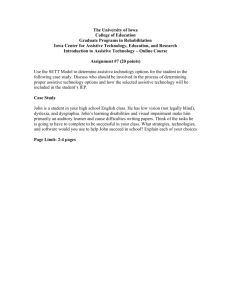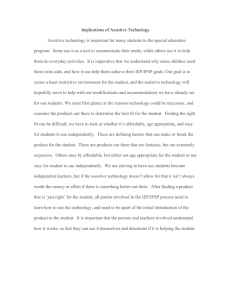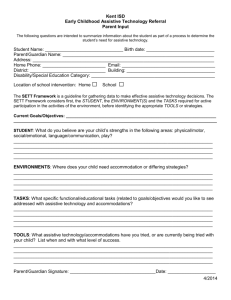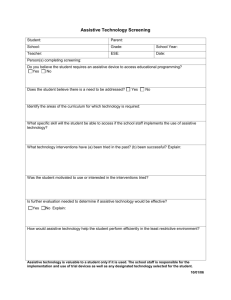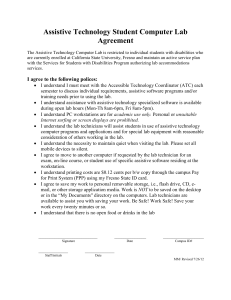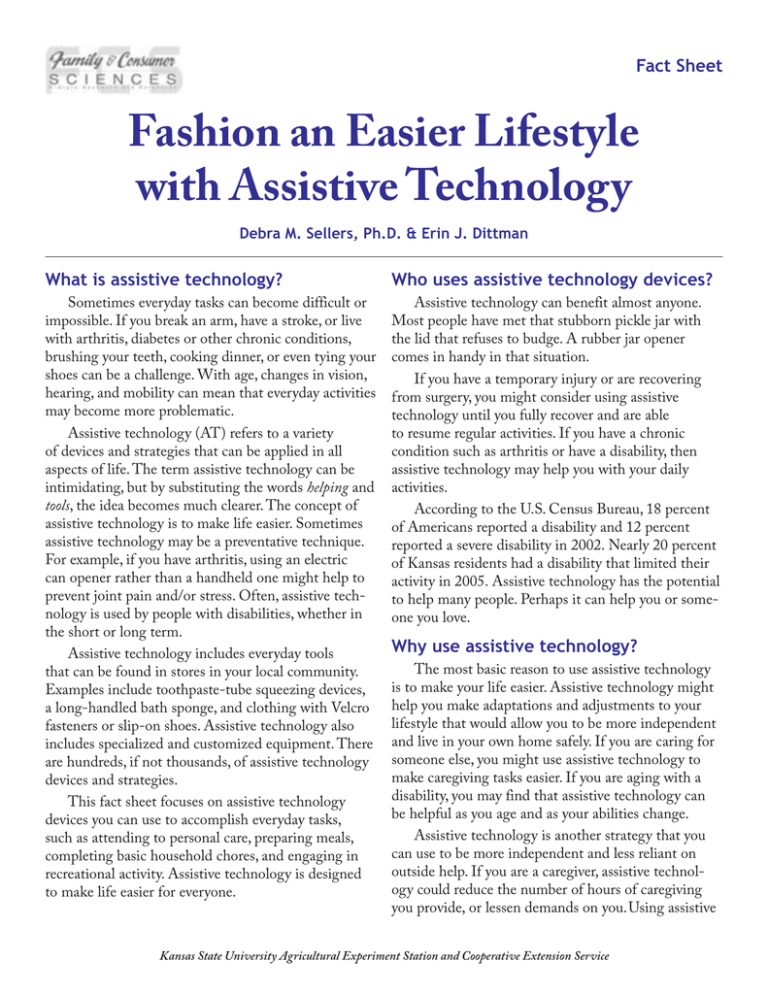
Fact Sheet
Fashion an Easier Lifestyle
with Assistive Technology
Debra M. Sellers, Ph.D. & Erin J. Dittman
What is assistive technology?
Who uses assistive technology devices?
Sometimes everyday tasks can become difficult or
impossible. If you break an arm, have a stroke, or live
with arthritis, diabetes or other chronic conditions,
brushing your teeth, cooking dinner, or even tying your
shoes can be a challenge. With age, changes in vision,
hearing, and mobility can mean that everyday activities
may become more problematic.
Assistive technology (AT) refers to a variety
of devices and strategies that can be applied in all
aspects of life. The term assistive technology can be
intimidating, but by substituting the words helping and
tools, the idea becomes much clearer. The concept of
assistive technology is to make life easier. Sometimes
assistive technology may be a preventative technique.
For example, if you have arthritis, using an electric
can opener rather than a handheld one might help to
prevent joint pain and/or stress. Often, assistive technology is used by people with disabilities, whether in
the short or long term.
Assistive technology includes everyday tools
that can be found in stores in your local community.
Examples include toothpaste-tube squeezing devices,
a long-handled bath sponge, and clothing with Velcro
fasteners or slip-on shoes. Assistive technology also
includes specialized and customized equipment. There
are hundreds, if not thousands, of assistive technology
devices and strategies.
This fact sheet focuses on assistive technology
devices you can use to accomplish everyday tasks,
such as attending to personal care, preparing meals,
completing basic household chores, and engaging in
recreational activity. Assistive technology is designed
to make life easier for everyone.
Assistive technology can benefit almost anyone.
Most people have met that stubborn pickle jar with
the lid that refuses to budge. A rubber jar opener
comes in handy in that situation.
If you have a temporary injury or are recovering
from surgery, you might consider using assistive
technology until you fully recover and are able
to resume regular activities. If you have a chronic
condition such as arthritis or have a disability, then
assistive technology may help you with your daily
activities.
According to the U.S. Census Bureau, 18 percent
of Americans reported a disability and 12 percent
reported a severe disability in 2002. Nearly 20 percent
of Kansas residents had a disability that limited their
activity in 2005. Assistive technology has the potential
to help many people. Perhaps it can help you or someone you love.
Why use assistive technology?
The most basic reason to use assistive technology
is to make your life easier. Assistive technology might
help you make adaptations and adjustments to your
lifestyle that would allow you to be more independent
and live in your own home safely. If you are caring for
someone else, you might use assistive technology to
make caregiving tasks easier. If you are aging with a
disability, you may find that assistive technology can
be helpful as you age and as your abilities change.
Assistive technology is another strategy that you
can use to be more independent and less reliant on
outside help. If you are a caregiver, assistive technology could reduce the number of hours of caregiving
you provide, or lessen demands on you. Using assistive
Kansas State University Agricultural Experiment Station and Cooperative Extension Service
technology might reduce the costs of in-home and
long-term care.
Sears Health and Wellness
www.searshealthandwellness.com
800-326-1750
What does assistive technology cost?
Who can help me?
Assistive technology devices may range in cost
from a few dollars for simple tools to thousands of
dollars for highly specialized equipment. Sometimes,
you can make your own devices from items already in
the house, or you can put certain household items to
use in a different way. For instance, a lazy Susan found
in the bottom of a kitchen cupboard may actually
be more useful on the countertop, where everyday
cooking items can be placed for easy access.
Consulting with an expert in assistive technology
who can assess your situation may prevent frustration
and wasted time and money. Many health care
professionals can assist you in selecting and locating
assistive technology that is best suited to your
particular situation and needs. A local physician may
be a good first referral source. Ask for help from an
occupational or physical therapist, or speech-language
pathologist. Each of these health care providers has a
different specialty, so be clear about your challenges
so that the best help can be provided. The Assistive
Technology for Kansans Project is also able to assist
you with questions regarding assistive technology.
Who pays for it?
At this time, most assistive technology is paid
for by individuals and their families from their own
personal funds. Almost all smaller tools are paid for in
this way. Sometimes, for bigger items that are deemed
medically necessary, Medicare, Medicaid, and private
insurance companies may help cover the cost. If you
are a veteran, check with your local Department of
Veterans Affairs.
Tell me more.
Following are a few descriptions of assistive
technology devices in four different areas. There are
thousands of possibilities. If a challenge exists for you,
it is likely that a piece of equipment has been invented
that may help you.
Where can someone get assistive
technology?
Personal care
• Buttoning tool to help with getting dressed
• Long-handled sponge to eliminate the need to
bend down to wash legs/feet
• Large-handled toothbrush for limited grip
Medical supply stores and pharmacies usually carry
some common assistive technology items. Others are
available through catalogs or online retailers. Efforts
are being made around the country to provide assistive
technology through lending and sharing programs.
Below are just a few suppliers of assistive
technology devices in a wide range of categories.
You could also search the Internet for other suppliers.
Active Forever
www.activeforever.com
800-377-8033
Meals
• Cutting board that holds food in place through
the use of spikes and a raised edge
• Rubber pad to keep a plate from moving on the
table
• Weighted silverware to help with tremors while
eating
AliMed
www.AliMed.com
800-225-2610
Household chores
• Long-handled dustpan to decrease the need to
kneel or stoop
• Reacher to pick up items on the floor or overhead
• Stool for sitting during cooking, folding laundry,
and other tasks
Gold Violin
www.goldviolin.com
877-648-8400
Sammons Preston
www.sammonspreston.com
800-323-5547
Recreational activity
• Card holder to ease strain from holding large
amounts of playing cards
• Modified keyboard or mouse for the computer to
reduce joint pain
• Bowling ramp to decrease strain on fingers, arms
and shoulders
on financial need. Assistance is not available to cover
the cost of prescription drugs, doctor bills or medical
treatments. The Arthritis Foundation also created an
Ease-of-Use Commendation program. To view these
products, visit www.arthritis.org/ease-of-use-new.php.
For more information, visit www.arthritis.org, keyword
“Kansas,” or call 800-362-1108.
More information
If you are interested in learning more about
assistive technology or related topics, please visit the
K-State Research and Extension Adult Development
and Aging Web site at www.aging.ksu.edu. The
following organizations may also be of help:
Catalog of Portable Electronic Devices
for Memory and Organization
This Web site is funded by the National Institute
on Disability and Rehabilitation Research, U.S.
Department of Education. This site focuses on assistive technology for those with challenges with their
memory and in staying organized. View a variety of
devices, including the price and manufacturer. To view
the site, go to http://www.biausa.org/Pages/AT/ or call
703-761-0750.
Assistive Technology for Kansans (ATK)
The Assistive Technology for Kansans Program
has five Assistive Technology Access Sites around
the state and is coordinated by Kansas University’s
Center on Disabilities. The program’s mission
is to support individuals with disabilities and/or
chronic health conditions in learning about and
acquiring assistive technology devices and services
they need for education, employment and living in
the community. As part of this mission, ATK staff
provide product information, device demonstration,
training and information about short-term loans, as
well as assistance in identifying public and private
funds for some equipment. The Assistive Technology
Access Sites are the point of contact for the Kansas
Equipment Exchange (KEE) and the Kansas
AgrAbility program. Through KEE, Kansans can
donate durable medical equipment they no longer
need or request a refurbished device if they need one.
For more information on any of these services, call
your regional AT Access Site (1-800-KAN-DO-IT)
or visit http://www.atk.ku.edu/.
Kansas AgrAbility Project
Kansas AgrAbility is coordinated by Kansas
State University and is part of a nationwide effort.
The project’s main mission is to help farmers with
disabilities continue to work in agriculture. Assistive
technology experts visit farmers and their families and
make recommendations for tools and adaptations. For
information, visit www.oznet.ksu.edu/agrability or call
1-800-KAN-DO-IT.
Kansas Department of Health and Environment
The Kansas Department of Health and
Environment (KDHE) works to ensure that healthy
Kansans are living in safe and sustainable environments. As part of this vision, the Arthritis Program
works to teach Kansans how to prevent or delay the
possibility of symptoms associated with arthritis.
For more information, visit www.kdheks.gov or call
785-296-8150.
Adapted Clothing for Veterans
Sew Much Comfort is a nationwide organization
that provides adapted clothing to soldiers with injuries.
Clothing is altered by volunteers and distributed free
of charge at military hospitals across the country and
around the world. For information on how to help, or
to receive clothing, visit www.sewmuchcomfort.org or
call the regional director for Kansas, Linda Trumble, at
303-581-0708.
Arthritis Foundation, Kansas Chapter
The Kansas Chapter of the Arthritis Foundation
helps individuals within its service area acquire equipment and personal care items that will enable them to
take control of their arthritis. The chapter also awards
scholarships for health and wellness programs based
Rehabilitation Engineering and Assistive
Technology Society of North America
This society is composed of people with an interest in both technology and disability, who work to
improve people’s lives through technology application. The society supports research and educational
activities, and provides advocacy services. For more
information, visit www.resna.org or call 703-524-6686
(Voice); 703-524-6639 (TTY).
References
Agree, E.M. and Freedman, V.A. (2000).
Incorporating assistive devices into communitybased long-term care. Journal of Aging and Health,
12(3), 426.
Carlson, D. and Ehrlich, N. (2006). Sources of
payment for assistive technology: Findings from
a national survey of persons with disabilities.
Assistive Technology, 18(1), 77.
Gitlin, L. (1995). Why older people accept or
reject assistive technology. Generations, 19(1), 41.
Hoening, H., Taylor, D. H. & Sloan, F. (2003).
Does assistive technology substitute for personal
assistance among the disabled elderly? American
Journal of Public Health, 93(2), 330.
Kansas Department of Health & Environment,
Office of Injury and Disability Programs. (n.d.).
Kansas state plan for promoting the health of
people with disabilities.
Mann, W., Ottenbacher, K., Fraas, L., Tomita, M.,
& Granger, C. (1999). Effectiveness of assistive
technology and environmental interventions in
maintaining independence and reducing home
care costs for the frail elderly. Archive of Family
Medicine, 8, 210.
U.S. Census Bureau. (2006). More than 50 million Americans report some level of disability.
Retrieved 11/19/2007 from http://www.census.
gov/Press-Release/www/releases/archives/aging_
population/006809.html.
Financial assistance provided by the Kansas Department of Health and Environment, Arthritis Program; The Arthritis Foundation,
Kansas Chapter; and the Assistive Technology for Kansans Project. This publication was supported by KDHE through
U58/CCU722793-05 from Centers for Disease Control and Prevention (CDC). Its contents are solely the responsibility of the
authors and do not necessarily represent the official views of CDC.
Brand names appearing in this publication are for product identification purposes only. No endorsement is intended,
nor is criticism implied of similar products not mentioned.
Publications from Kansas State University are available on the World Wide Web at: www.oznet.ksu.edu
Contents of this publication may be freely reproduced for educational purposes. All other rights reserved. In each case, credit
Debra M. Sellers and Erin J. Dittman, Fashion an Easier Lifestyle with Assistive Technology,
Kansas State University, July 2008.
Kansas State University Agricultural Experiment Station and Cooperative Extension Service
MF-2837
July 2008
K-State Research and Extension is an equal opportunity provider and employer. Issued in furtherance of Cooperative Extension Work, Acts of May 8 and June 30, 1914, as
amended. Kansas State University, County Extension Councils, Extension Districts, and United States Department of Agriculture Cooperating, Fred A. Cholick, Director.

